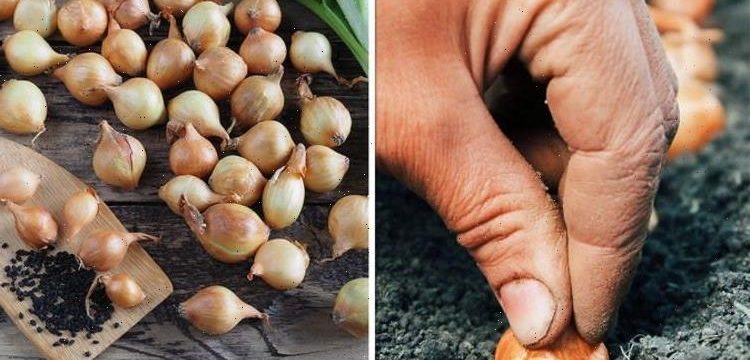Gardening expert demonstrates how to get rid of weeds
We use your sign-up to provide content in ways you’ve consented to and to improve our understanding of you. This may include adverts from us and 3rd parties based on our understanding. You can unsubscribe at any time. More info
Shallots are one of the easiest bulb vegetables to grow in the garden due to their small size and undemanding nature. These tasty alliums require little growing space and offer a low maintenance, high-yield crop – perfect for use in your summer recipes. Getting shallots growing in your garden can be done in just a few simple steps – and this is how to plant them.
When to plant shallots
Shallots have a long planting season stretching from late autumn through to spring.
According to Gardeners’ World, the best time to plant these sweet vegetables is between November and April.
Your crop is likely to be heavier the earlier you plant them, so expect more onion-like growth from autumn crops and lighter shallots from late winter or spring crops.
These small alliums are best planted from sets of small shallots, though they can be raised from seed.


How to plant shallots
Planting out shallots from a set is very simple and they will often grow strong and flavoursome when planted in the right soil.
Choose a raised bed or open ground with moist but well-drained soil for best results.
Gardeners’ World says: “Like onions, shallots prefer sun and a moisture-retentive, fertile soil, ideally with plenty of well-rotted organic matter such as garden compost added.
“It’s worth looking for heat-treated shallot sets, as the resulting plants are less prone to bolting (producing flowers). Bolting reduces the quality of the crop.”
Avoid planting in a weeded area and keep the crop watered in dry conditions.

Prepare the soil
The Royal Horticultural Society (RHS) recommends treating the soil for an improved growing environment for your shallots.
Fill the soil with plenty of organic matter ahead of digging in your sets.
The RHS says: “Apply a bucketful of well-rotted manure or garden compost per square metre/yard. This will help add nutrients, improve the soil structure and hold moisture in the soil.”
DON’T MISS:
February gardening: Nine jobs to do in the garden next week [INSIGHT]
10 most common birds in British gardens – how many can you spot? [ANALYSIS]
‘Could save you hours this year’: Gardening ‘jobs’ to do in February [REVEAL]

Space out your sets
Once you’ve chosen the location for your shallots, take a long thin strip of wood to measure out the spacing between your sets.
Most shallots grow best when planted between six and nine inches apart, with around 12 inches between each row.
Mark out six to nine-inch spaces along the length of the wood for easy planting.
Each shallot will produce multiple bulbs, so be vigilant with your spacing to maximise the growth of your crop.

Dig in your shallots
Once your wood is laid flat on the soil, begin digging out a small hole at each marking to plant your shallots.
Use a trowel to lightly push away the soil and place the shallot root down, leaving the tip exposed above the soil.
Lightly press the earth around the planted shallot and repeat until the width of your bed is filled.
Raised beds are very fertile, so your shallots will grow well when planted equidistant from one another – even if some are larger than others.
Repeat in rows
Move your wooden ruler from the current row and measure around 12 to 18 inches from above the planted shallots – (this should be between one and two spaces already marked out on the wood).
Turn the ruler to run parallel with the existing row and begin planting another run of shallots.
Cover your sets
Birds are particularly attracted to newly planted sets, so always take steps to protect your shallots.
Cover with a fleece or netting until they’re rooted in to stop birds from pulling up the fresh bulbs.
Top tips for growing shallots:
- Shallots are shallow rooting, so always hand weed rather than hoe between rows
- Alliums planted in autumn will benefit from a nitrogen-rich fertiliser applied in spring
- Plant rows of shallots in between established roses to deter insects and attract pollinators
- Alliums do well near carrots as they help to deter carrot root fly
Source: Read Full Article
